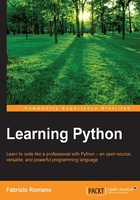
Chapter 1. Introduction and First Steps – Take a Deep Breath
"Give a man a fish and you feed him for a day. Teach a man to fish and you feed him for a lifetime."
--Chinese proverb
According to Wikipedia, computer programming is:
"...a process that leads from an original formulation of a computing problem to executable computer programs. Programming involves activities such as analysis, developing understanding, generating algorithms, verification of requirements of algorithms including their correctness and resources consumption, and implementation (commonly referred to as coding) of algorithms in a target programming language".
In a nutshell, coding is telling a computer to do something using a language it understands.
Computers are very powerful tools, but unfortunately, they can't think for themselves. So they need to be told everything. They need to be told how to perform a task, how to evaluate a condition to decide which path to follow, how to handle data that comes from a device such as the network or a disk, and how to react when something unforeseen happens, say, something is broken or missing.
You can code in many different styles and languages. Is it hard? I would say "yes" and "no". It's a bit like writing. Everybody can learn how to write, and you can too. But what if you wanted to become a poet? Then writing alone is not enough. You have to acquire a whole other set of skills and this will take a longer and greater effort.
In the end, it all comes down to how far you want to go down the road. Coding is not just putting together some instructions that work. It is so much more!
Good code is short, fast, elegant, easy to read and understand, simple, easy to modify and extend, easy to scale and refactor, and easy to test. It takes time to be able to write code that has all these qualities at the same time, but the good news is that you're taking the first step towards it at this very moment by reading this book. And I have no doubt you can do it. Anyone can, in fact, we all program all the time, only we aren't aware of it.
Would you like an example?
Say you want to make instant coffee. You have to get a mug, the instant coffee jar, a teaspoon, water, and the kettle. Even if you're not aware of it, you're evaluating a lot of data. You're making sure that there is water in the kettle as well as the kettle is plugged-in, that the mug is clean, and that there is enough coffee in the jar. Then, you boil the water and maybe in the meantime you put some coffee in the mug. When the water is ready, you pour it into the cup, and stir.
So, how is this programming?
Well, we gathered resources (the kettle, coffee, water, teaspoon, and mug) and we verified some conditions on them (kettle is plugged-in, mug is clean, there is enough coffee). Then we started two actions (boiling the water and putting coffee in the mug), and when both of them were completed, we finally ended the procedure by pouring water in the mug and stirring.
Can you see it? I have just described the high-level functionality of a coffee program. It wasn't that hard because this is what the brain does all day long: evaluate conditions, decide to take actions, carry out tasks, repeat some of them, and stop at some point. Clean objects, put them back, and so on.
All you need now is to learn how to deconstruct all those actions you do automatically in real life so that a computer can actually make some sense of them. And you need to learn a language as well, to instruct it.
So this is what this book is for. I'll tell you how to do it and I'll try to do that by means of many simple but focused examples (my favorite kind).